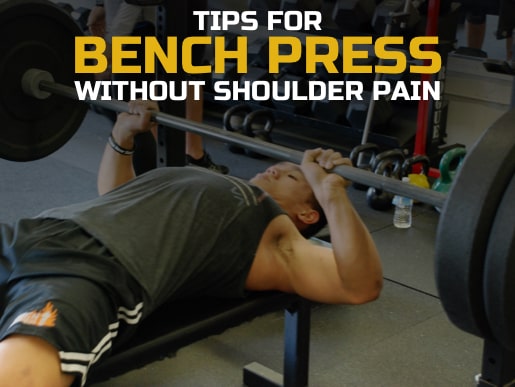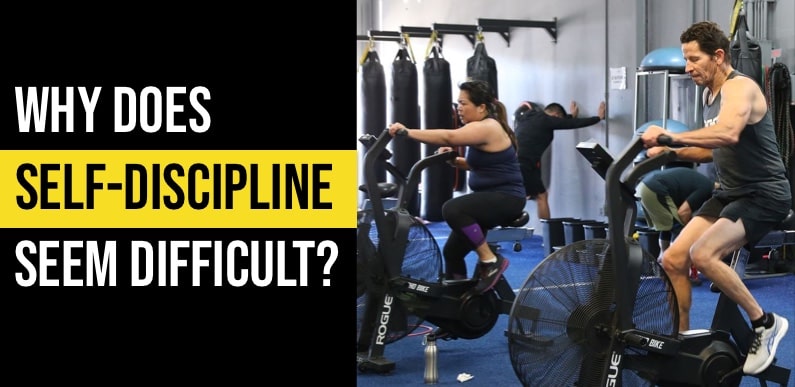Overall, the bench press is one of the most potent barbell pressing exercises at our disposal.
There’s no reason it needs to cause shoulder pain. Try narrowing your grip, and keep those shoulder blades locked and stable against the bench.
In addition, performing the lift from a slight incline and increasing your overhead pressing volume can benefit.
Use these 5 tips to eliminate shoulder pain during the bench press!

1. Alter your grip width
Altering our grip width is the first line of defense to combat nagging shoulder pain during the bench press. Adjusting the grip width can help shift stress off sensitized structures, making it more comfortable for you overall. I recommend narrowing AND widening the grip to see what works best for you.
This grip change shouldn’t be drastic; start with simply moving each hand in a half-inch and re-assess. If this eliminates your shoulder pain, you’ve found your golden ticket!
2. Keep your shoulder blades retracted
A significant problem during the bench press is a lack of upper back tightness. If the scapulae do not stay locked in retraction the entire lift, this can cause anterior scapular tilt at the bottom of the bench press leading to anterior shoulder discomfort.
It amazes me that people still believe scapular motion should occur during the bench press. Conventional wisdom would suggest that as one presses the weight, the scapulae should protract to promote optimal scapulohumeral rhythm.
Then on the descent, the scapulae should retract once again. While, in theory, this makes sense, it comes at the cost of sacrificing stability.
Trying to repetitively retract and protract the scapulae while pinned to a bench against a heavy load is futile, as it is nearly impossible to perform and sacrifices stability. Instead, it would be best to train proper scapulohumeral rhythm with other exercises where the scapulae are free to rotate, such as the push-up, landmine press, and overhead press.
For the bench press, keep those shoulder blades locked in retraction; this is the safest and most mechanically efficient way to save your shoulders and increase performance.
3. Try the low incline bench press
For those who aren’t training for a powerlifting meet and are repetitively “beat up” by the standard bench press, inclining the bench press just a tad can be an excellent solution. If you have the correct adjustable bench, set it just one notch above flat.
The slight angle allows the chest to play a role, sparing the shoulder joint. So, in addition to being a great “shoulder saver,” this is a tremendous variation for those who can never seem to feel the bench press in their chest.
While this may not be a viable solution for the powerlifters out there who don’t have a choice but to perform the bench press, this represents an excellent option for the average joe, weekend warrior, and athlete!
4. Increase your overhead pressing volume
Often a culprit of shoulder pain during the bench press can be attributed to simply too much bench pressing. As mentioned in the last paragraph, bench pressing is performed with the shoulder blades locked in retraction. While this is the most efficient and safest way to achieve the lift, one must appropriately balance it with other exercises that train proper scapulohumeral rhythm.
Decreasing your bench press volume and increasing overhead pressing work can promote balance at the shoulder joint and help alleviate nagging shoulder pain.
5. Perform posterior shoulder soft-tissue work
A proper warm-up is critical for preventing shoulder pain during the bench press. While simple exercises such as scapular retractions, push-ups, and external rotation work are great tools, I’ve found that performing soft tissue work directly before bench pressing can also benefit greatly.
Roll your posterior shoulder on a tennis or lacrosse ball for around 10 slow reps to perform while lying on your side. After that, slowly go through internal and external rotation motions on top of the ball. To clarify the purpose of this, NO, we aren’t breaking up any “adhesions” or releasing any tissue “restrictions”; we are simply providing a novel stimulus to the nervous system to decrease tone. This can transiently increase shoulder ROM (especially internal rotation), leading to a more comfortable bench press.
There’s no need to press hard into the ball; this should not be painful. Again, we aren’t breaking up any adhesions or digging any “knots” out.
Finally, include some soft tissue work in your warm-up to help decrease tone and increase ROM.
The bench press represents a staple upper body pressing exercise that increases strength, power, and hypertrophy. Increasing your bench press is a highly sought-after goal for athletes and “bros” alike!
However, nagging shoulder pain often tends to get in these endeavors.
For more Accountability-related blogs, click here
https://fns360.live/blog/category/accountability-2/.
You can also check out more such videos,
The Huddle with Coach Brian Nunez – Mindset Motivation & Interviews.






